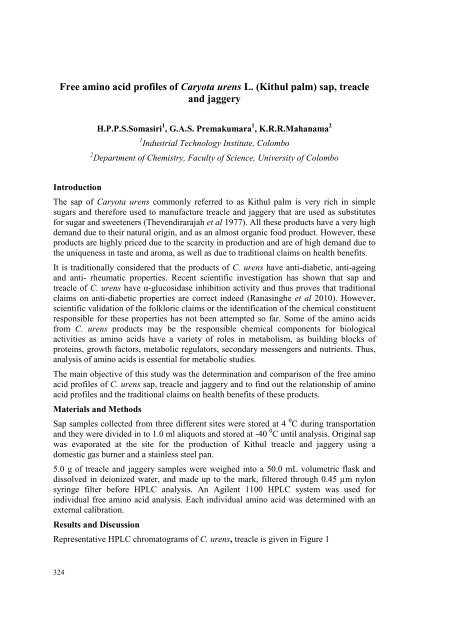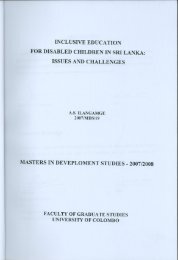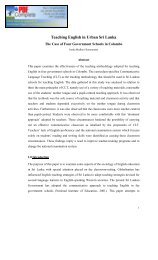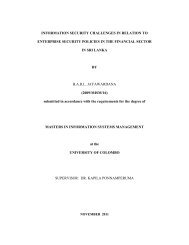Free amino acid profiles of Caryota urens L. (Kithul palm) sap ...
Free amino acid profiles of Caryota urens L. (Kithul palm) sap ...
Free amino acid profiles of Caryota urens L. (Kithul palm) sap ...
You also want an ePaper? Increase the reach of your titles
YUMPU automatically turns print PDFs into web optimized ePapers that Google loves.
324<br />
<strong>Free</strong> <strong>amino</strong> <strong>acid</strong> <strong>pr<strong>of</strong>iles</strong> <strong>of</strong> <strong>Caryota</strong> <strong>urens</strong> L. (<strong>Kithul</strong> <strong>palm</strong>) <strong>sap</strong>, treacle<br />
and jaggery<br />
Introduction<br />
H.P.P.S.Somasiri 1 , G.A.S. Premakumara 1 , K.R.R.Mahanama 2<br />
1 Industrial Technology Institute, Colombo<br />
2 Department <strong>of</strong> Chemistry, Faculty <strong>of</strong> Science, University <strong>of</strong> Colombo<br />
The <strong>sap</strong> <strong>of</strong> <strong>Caryota</strong> <strong>urens</strong> commonly referred to as <strong>Kithul</strong> <strong>palm</strong> is very rich in simple<br />
sugars and therefore used to manufacture treacle and jaggery that are used as substitutes<br />
for sugar and sweeteners (Thevendirarajah et al 1977). All these products have a very high<br />
demand due to their natural origin, and as an almost organic food product. However, these<br />
products are highly priced due to the scarcity in production and are <strong>of</strong> high demand due to<br />
the uniqueness in taste and aroma, as well as due to traditional claims on health benefits.<br />
It is traditionally considered that the products <strong>of</strong> C. <strong>urens</strong> have anti-diabetic, anti-ageing<br />
and anti- rheumatic properties. Recent scientific investigation has shown that <strong>sap</strong> and<br />
treacle <strong>of</strong> C. <strong>urens</strong> have α-glucosidase inhibition activity and thus proves that traditional<br />
claims on anti-diabetic properties are correct indeed (Ranasinghe et al 2010). However,<br />
scientific validation <strong>of</strong> the folkloric claims or the identification <strong>of</strong> the chemical constituent<br />
responsible for these properties has not been attempted so far. Some <strong>of</strong> the <strong>amino</strong> <strong>acid</strong>s<br />
from C. <strong>urens</strong> products may be the responsible chemical components for biological<br />
activities as <strong>amino</strong> <strong>acid</strong>s have a variety <strong>of</strong> roles in metabolism, as building blocks <strong>of</strong><br />
proteins, growth factors, metabolic regulators, secondary messengers and nutrients. Thus,<br />
analysis <strong>of</strong> <strong>amino</strong> <strong>acid</strong>s is essential for metabolic studies.<br />
The main objective <strong>of</strong> this study was the determination and comparison <strong>of</strong> the free <strong>amino</strong><br />
<strong>acid</strong> <strong>pr<strong>of</strong>iles</strong> <strong>of</strong> C. <strong>urens</strong> <strong>sap</strong>, treacle and jaggery and to find out the relationship <strong>of</strong> <strong>amino</strong><br />
<strong>acid</strong> <strong>pr<strong>of</strong>iles</strong> and the traditional claims on health benefits <strong>of</strong> these products.<br />
Materials and Methods<br />
Sap samples collected from three different sites were stored at 4 0 C during transportation<br />
and they were divided in to 1.0 ml aliquots and stored at -40 0 C until analysis. Original <strong>sap</strong><br />
was evaporated at the site for the production <strong>of</strong> <strong>Kithul</strong> treacle and jaggery using a<br />
domestic gas burner and a stainless steel pan.<br />
5.0 g <strong>of</strong> treacle and jaggery samples were weighed into a 50.0 mL volumetric flask and<br />
dissolved in deionized water, and made up to the mark, filtered through 0.45 µm nylon<br />
syringe filter before HPLC analysis. An Agilent 1100 HPLC system was used for<br />
individual free <strong>amino</strong> <strong>acid</strong> analysis. Each individual <strong>amino</strong> <strong>acid</strong> was determined with an<br />
external calibration.<br />
Results and Discussion<br />
Representative HPLC chromatograms <strong>of</strong> C. <strong>urens</strong>, treacle is given in Figure 1
Table 1, <strong>Free</strong> Amino Acid Content (mg/100g) <strong>of</strong> <strong>Kithul</strong> <strong>sap</strong>, treacle, and jaggery<br />
Amino <strong>acid</strong> Product type<br />
Sap (n=20) Treacle (n=17) 4 Jaggery (n=6)<br />
Aspartate 8 ± 1.5 38 ± 6 43 ± 6<br />
Glutamate 16 ± 3.2 73 ± 12 93 ± 12<br />
Asparagine 11 ± 2.3 54 ± 5 59 ± 6<br />
Serine 14 ± 2.8 71 ± 8 84 ± 8<br />
Histidine 6 ± 1.3 28 ± 3 32 ± 3<br />
Glycine 2 ± 0.3 8 ± 1 10 ± 1<br />
Threonine 1.5 ± 0.3 4 ± 0.5 6 ± 0.5<br />
Arginine 10 ± 1.5 50 ± 7 54 ± 6<br />
Alanine 4 ± 1.3 18 ± 3 23 ± 3<br />
Tryrosine 2 ± 0.4 8 ± 1 10 ± 1<br />
Cystine 4 ± 1.2 17 ± 2 19 ± 2<br />
Valine ND ND ND<br />
Methionine 2 ± 0.3 7 ± 1 9 ± 1<br />
Phenylalanine 2 ± 0.2 5 ± 1 8 ± 1<br />
Isoleucine 4 ± 0.4 15 ± 2 20 ± 2<br />
Leucine 1 ± 0.3 3 ± 0.5 5 ± 0.7<br />
Lysine 1± 0.2 3 ± 0.2 3 ± 0.2<br />
Proline 3 ± 0.7 12 ± 1.5 15 ± 2.4<br />
ND = Not Detected<br />
Quantitative results <strong>of</strong> each <strong>amino</strong> <strong>acid</strong> in <strong>sap</strong>, treacle and jaggery are summarized in<br />
Table 1. Results are expressed as the mean and the respective standard error <strong>of</strong> mean<br />
(SEM).<br />
Results showed that C. <strong>urens</strong> <strong>sap</strong>, treacle and jaggery contain glutamate, serine,<br />
asparagine arginine, and aspartate as the major <strong>amino</strong> <strong>acid</strong>s in mg /100g and valine was<br />
absent.<br />
Relatively high amount <strong>of</strong> glutamate in the C. <strong>urens</strong> <strong>sap</strong>, treacle and jaggery, which is a<br />
known flavor enhancer, could be the main contributor for the unique flavour <strong>of</strong> the <strong>Kithul</strong><br />
products (Belitz and Grosch, 1999). None <strong>of</strong> the other treacle types has glutamate levels<br />
325
similar to <strong>Kithul</strong> treacle (Somasiri et al 2011). Folkloric claim <strong>of</strong> <strong>Kithul</strong> products having<br />
the potential <strong>of</strong> sexual arousal on consumption may be due to arginine which is considered<br />
as ''The Natural Viagra" that increases the libido and potency confirms the chemical<br />
responsible for the effect. The effect may be further enhanced by the presence <strong>of</strong> histidine,<br />
and tyrosine which are known for contribute in reproduction (Balch 2005). The presence<br />
<strong>of</strong> methionine and cystine suggest very high antioxidant activity. Cystine has also been<br />
identified as a treatment for rheumatoid arthritis and hardening <strong>of</strong> the arteries. The<br />
traditional claim that <strong>Kithul</strong> <strong>sap</strong> is good for arthritis is supported due to the presence <strong>of</strong><br />
considerable amount <strong>of</strong> histidine. Furthermore, the presence <strong>of</strong> proline improves skin<br />
texture by aiding the production <strong>of</strong> collagen and reducing the loss <strong>of</strong> collagen in the aging<br />
process.<br />
Conclusion<br />
This report is the first study on the <strong>amino</strong> <strong>acid</strong> pr<strong>of</strong>ile <strong>of</strong> C. <strong>urens</strong> <strong>sap</strong> and jaggery. <strong>Free</strong><br />
<strong>amino</strong> <strong>acid</strong> <strong>pr<strong>of</strong>iles</strong> <strong>of</strong> <strong>Kithul</strong> <strong>sap</strong>, treacle and jaggery can be used to explain some <strong>of</strong> the<br />
traditional claims on the health benefits <strong>of</strong> these products and is also useful for nutrition<br />
labeling <strong>of</strong> these products.<br />
References<br />
Balch, P. and James Balch, M.D. (2000), Prescription For Nutritional Healing, Avery Books.<br />
Belitz, H. D. and Grosch, W. (1999). Fruits and fruit products. In Food Chemistry. Berlin: Springer (pp.<br />
748–757).<br />
Ranasinghe, P., Premakumara G.A.S, Wijeyarathna C.D., Ratnasooriya, W.D. 2010. Antioxident avctivity<br />
<strong>of</strong> <strong>Caryota</strong> <strong>urens</strong> L. treacle. Annual Sessions, University <strong>of</strong> Colombo.<br />
Somasiri H.P.P.S, Premakumara G.A.S, Mahanama K.R.R. (2011), <strong>Free</strong> <strong>amino</strong> <strong>acid</strong> pr<strong>of</strong>ile <strong>of</strong> <strong>Kithul</strong> <strong>palm</strong><br />
<strong>Caryota</strong> <strong>urens</strong> L. treacle and its potential application in authentication <strong>of</strong> treacle types, Proceeding <strong>of</strong><br />
the 12 th Government Food Analysts Conference.<br />
Thevendirarajah K., Dassanayake M.D., and Jeyaseelan K. Ceylon J. Sci. (Bio.Sci.) Vol 12, No.2, 146-150,<br />
November 1977.<br />
Financial support from Treasury Grant No. 10719 / TG 10 is acknowledged.<br />
326





